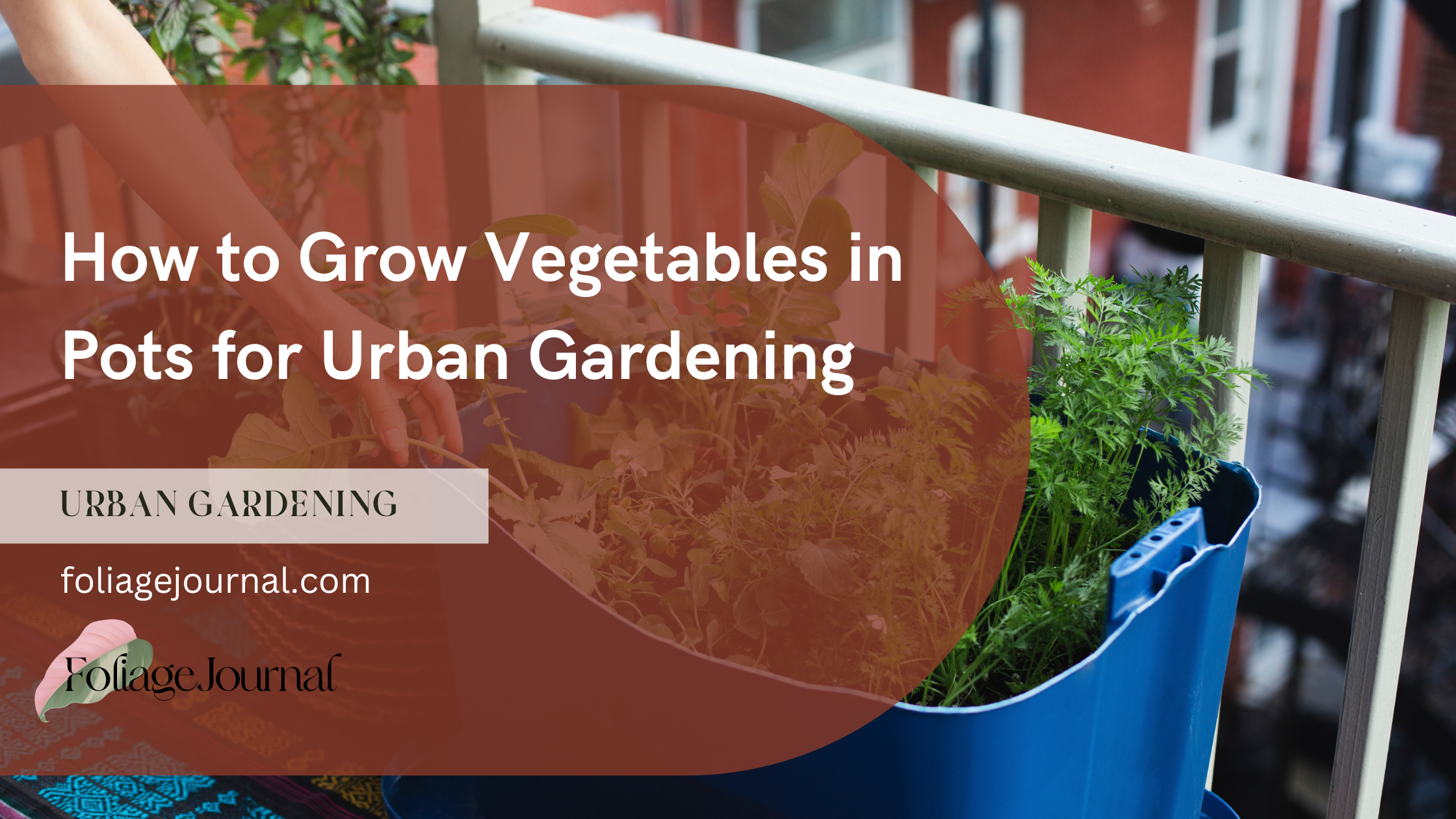Urban gardening has become increasingly popular in recent years, as more and more people are looking for ways to grow their own fresh produce, even in limited spaces. Growing vegetables in pots is an excellent solution for those who don’t have access to a traditional garden plot.
In this article, we will explore how to grow vegetables in containers, providing tips and techniques for beginners who want to start their own urban garden.
Benefits of Growing Vegetables in Pots.
Growing vegetables in pots offers numerous benefits, especially for urban dwellers. Firstly, it allows you to maximize your available space, whether you have a small balcony, patio, or even just a sunny windowsill.
Additionally, container gardening provides better control over soil quality, as you can easily customize the growing medium to suit the needs of your plants.
Furthermore, growing vegetables at home using pots can be a rewarding and cost-effective way to access fresh, organic produce right at your doorstep.
So, how to grow vegetables in pots for urban gardening?
Choosing the Right Containers.

When it comes to how to grow vegetables in pots for urban gardening, selecting the appropriate containers is crucial. The size of the pot will depend on the type of vegetable you want to grow. For example, shallow-rooted crops like lettuce and herbs can thrive in containers as small as 6 inches deep, while larger vegetables like tomatoes and eggplants require pots that are at least 12 inches deep and wide. It’s essential to choose pots with adequate drainage holes to prevent waterlogging, which can lead to root rot. You can also opt for self-watering containers, which have built-in reservoirs that help maintain consistent moisture levels.
When learning how to grow vegetables in containers, it’s important to consider the material of the pots as well.
Terra cotta pots are popular for their aesthetic appeal and porous nature, which allows for better air circulation and drainage. However, they can dry out quickly and may require more frequent watering.
Plastic pots are lightweight, affordable, and retain moisture well, making them a great choice for beginners who are learning how to grow vegetables at home using pots.
Fabric grow bags are another excellent option, as they promote air pruning of roots and prevent plants from becoming root-bound.
The color of your containers can also play a role in the success of your urban garden. Dark-colored pots absorb more heat, which can be beneficial in cooler climates but may cause the soil to overheat in hot weather.
Light-colored pots, on the other hand, reflect sunlight and help keep the soil cooler, making them a better choice for growing vegetables in pots in warm regions.
When growing vegetables in pots for beginners, it’s also essential to consider the space you have available. If you have limited floor space, consider using hanging baskets or wall-mounted containers to maximize your vertical growing area.
Railing planters are perfect for small balconies, while window boxes can be used to grow herbs and compact vegetables indoors.
Ultimately, the key to choosing the right containers when learning how to grow vegetables in pots for urban gardening is to select pots that provide ample space for root growth, ensure proper drainage, and suit your specific growing conditions and aesthetic preferences.
Soil and Fertilizer.
To ensure the success of your urban garden, it’s crucial to use high-quality potting soil that is well-draining and rich in organic matter.
When learning how to grow vegetables in pots for urban gardening, avoid using garden soil, as it can be too heavy and may contain weed seeds or disease-causing organisms.
Instead, opt for a commercial potting mix specifically designed for growing vegetables in containers. These mixes often contain a blend of peat moss, compost, perlite, and vermiculite, which provide excellent drainage, aeration, and water retention properties.
If you prefer to create your own potting mix for growing vegetables in pots, a simple recipe is to combine equal parts peat moss, compost, and perlite. Peat moss helps retain moisture and provides a lightweight, airy structure to the soil. Compost adds essential nutrients and beneficial microorganisms, while perlite improves drainage and prevents soil compaction.
When mixing your own potting soil, be sure to use high-quality ingredients and avoid using soil from your garden, as it may not be suitable for container gardening.
Regular fertilization is essential when growing vegetables in containers, as the limited soil volume can quickly become depleted of nutrients. When learning how to grow vegetables at home using pots, it’s important to choose the right fertilizer for your plants.
Slow-release fertilizers are an excellent option for beginners, as they gradually release nutrients over an extended period, reducing the risk of over-fertilization. These fertilizers typically come in the form of pellets or granules that you mix into the soil at planting time.
In addition to slow-release fertilizers, you can also use liquid fertilizers to provide a quick boost of nutrients to your container-grown vegetables. Liquid fertilizers are easy to apply and can be diluted to the appropriate strength for your plants. When using liquid fertilizers, be sure to follow the manufacturer’s instructions carefully to avoid over-fertilizing, which can damage your plants.
Organic fertilizers, such as compost tea, fish emulsion, and seaweed extract, are also excellent choices for growing vegetables in pots for urban gardening. These natural fertilizers provide a wide range of nutrients and beneficial microorganisms that support plant health and improve soil structure. When using organic fertilizers, apply them more frequently than synthetic options, as they tend to release nutrients more slowly.
Lastly, when learning how to grow vegetables in pots for beginners, it’s essential to monitor your plants regularly for signs of nutrient deficiencies, such as yellowing leaves or stunted growth. If you notice these symptoms, address them promptly by adjusting your fertilization schedule or applying a targeted nutrient supplement. By providing your container-grown vegetables with the right soil and fertilizer, you’ll be well on your way to enjoying a bountiful harvest from your urban garden.
Sunlight and Watering.
Most vegetables require at least 6 hours of direct sunlight per day to grow successfully. When growing vegetables in pots for urban gardening, it’s important to place your containers in a location that receives ample sunlight.
If your space has limited direct sunlight, consider growing leafy greens and herbs, which can tolerate some shade. Proper watering is also crucial for container-grown vegetables.
The soil in pots tends to dry out more quickly than in-ground gardens, so regular watering is necessary. Water your plants deeply and thoroughly, ensuring that the water reaches the roots. To minimize evaporation and maintain consistent moisture levels, consider mulching the soil surface with organic materials like straw or shredded leaves.
Choosing the Right Vegetables.

When starting your urban garden, it’s essential to choose vegetables that are well-suited for growing in pots. Some excellent options for beginners include:
- Tomatoes: Cherry or dwarf varieties are ideal for container gardening.
- Leafy greens: Lettuce, spinach, and kale are easy to grow and can be harvested continuously.
- Herbs: Basil, mint, and cilantro are flavorful additions to any urban garden.
- Peppers: Both sweet and hot peppers can thrive in pots.
- Beans: Bush varieties of beans are compact and perfect for containers.
Remember to consider the mature size of the plants when selecting your vegetables, and choose varieties that are specifically bred for container gardening when possible.
Pest and Disease Management.
Growing vegetables in pots can help reduce the risk of pest and disease problems, as containers provide a more controlled environment. However, it’s still essential to be vigilant and take preventive measures.
Regularly inspect your plants for signs of pests, such as aphids or whiteflies, and remove them manually or treat with insecticidal soaps if necessary.
To prevent fungal diseases, avoid wetting the foliage when watering and ensure proper air circulation around your plants. If you notice any diseased leaves, remove them promptly to prevent the spread of infection.
Harvesting and Succession Planting.
One of the joys of growing vegetables at home using pots is the ability to harvest fresh produce right when you need it.
Regularly harvesting your vegetables not only ensures the best flavor and texture but also encourages the plants to continue producing.
To maximize your yields and extend your harvest season, consider succession planting. This involves planting new crops every few weeks, so you always have a steady supply of fresh vegetables. As you harvest one crop, replace it with another, making the most of your limited space.
Container Gardening Tips and Tricks.
To further enhance your success when growing vegetables in pots for urban gardening, consider these tips and tricks:
- Use light-colored containers to reflect heat and keep roots cooler in hot weather.
- Group containers together to create a microclimate and improve humidity levels.
- Rotate your containers periodically to ensure even sun exposure on all sides.
- Use companion planting to deter pests and improve plant health.
- Experiment with different container materials, such as fabric grow bags or recycled containers, to find what works best for your space and budget.
Conclusion.
Growing vegetables in pots for urban gardening is a rewarding and accessible way to enjoy fresh, homegrown produce, even in limited spaces. By following the tips and techniques outlined in this article, beginners can successfully start their own container gardens and experience the satisfaction of harvesting their own vegetables. With a little creativity and attention to detail, anyone can become a successful urban gardener, enjoying the many benefits of growing vegetables at home using pots.

